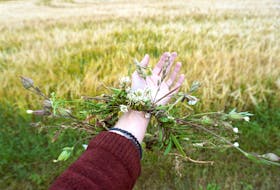Health officials agree that nothing works better than social distancing and careful handwashing when it comes to stopping the spread of coronavirus, but face masks can have a role to play in preventing its transmission too, particularly when people are asymptomatic.
With worldwide supply issues of N95 and surgical masks, we want to leave them for our health-care workers. Cloth face masks are good for our purposes, when we are in places like the supermarket or on public transit and social distancing is not possible.
Interested in sewing your own face masks? Read on for easy instructions and a step-by-step video tutorial to make your own cloth masks, even if you’re a beginner. A sewing machine is ideal but not a necessity- you can sew it by hand if you want to. It’s actually your clothes iron that does the most work here!
The best fabric for a homemade mask, according to the Centers for Disease Control and Prevention, is a tightly woven cotton. Quilter’s cotton is perfect, but if you don’t have any on hand, a pillowcase or sheet would also work. Wash your fabric in hot water and machine dry it before you sew so that any shrinkage will happen now and not later.
This mask has a pocket for a filter insert. For this one I used a piece of shop towel, but you could also use another piece of cotton or a piece of tea towel or other breathable fabric.
Let’s go!

For this mask, you will need:
- One piece of cotton, 9x14 inches
- Two pieces of elastic, about 6.5 inches each
- A wire for a nose clip (I used aluminum wire and turned in the ends. You could also use a twist tie or an unfolded paper clip, if the ends are not sharp)
- One piece of filter fabric, about 6.5 x 3.5 inches (I used a piece cut from a shop towel, but a piece of tea towel also works).
- Scissors
- Chalk or dressmaker’s pen
- Pins
- Measuring tape
- Iron
Step 1:
Lay your cotton fabric flat with the wrong side facing up. On the long sides, measure and mark a point one inch in from the edge. On the short sides, measure and mark two points: one at 0.5 inches, and one at 1.5 inches.

Step 2:
Fold the long edges of your fabric in to the mark you measured, then use your iron to press the edge flat. Then do the short sides: fold the edge of the fabric to the 0.5 inch mark, then press it, then fold it down again to the 1.5 inch mark and press again. This way you will see no raw edge on the short sides of your fabric.

Step 3:
On one of the short sides of the fabric, sew a hem about ¼ inch from the folded edge. You only need to do this on one short side. This little tunnel you’ve created will be the casing for your nose clip.

Step 4:
Poke the nose clip into the casing and push it to the middle of the fabric.

Step 5:
Lay your fabric flat again with the wrong side facing up. Fold it in half widthwise (short sides together). Use your iron to press this fold.
Step 6:
With the fabric still folded in half and the side with the nose clip facing DOWN (this is important), fold your fabric again, this time lengthwise: bring the bottom and top edges to meet in the middle. Then fold in half so you have a long, thin rectangle. Press these folds to make sharp creases.

Step 7:
Unfold the last three folds you made, so you have a square of fabric with three horizontal creases in it. Turn the fabric over so now the nose clip is facing UP.

Step 8:
Pinch the first crease and fold it down to a spot halfway to the next crease.

Pin it in place on the left and right sides of your fabric. Do the same for the second crease. Do the same for the third crease, pinning it halfway to the bottom. Your fabric should now look like this:

Step 9:
Now we add the elastic for the ear straps. Take one piece of elastic and tuck the ends between the layers of fabric at the top and bottom of your mask on the right side. Do the same for the left side. It can be helpful to pin or hand-sew a little stitch to keep it in place for now.

Step 10:
Sew down the left and right edges, catching the elastic as you sew. I like to sew it a second time, just to reinforce the elastic.


That’s it! You now have a wearable face mask. Place your filter fabric flat inside the pocket and wear it with the nose clip facing the outside.

Make sure to bend the clip so the mask fits snugly to your face without any gaping. If you like, you could put elastic on the bottom edge of the mask, to fit it more snugly underneath your chin.

To wash your mask, remove the insert and throw it in the washing machine in warm water and detergent on a delicate cycle. Machine dry.
Health officials say when wearing a mask in public, make sure it’s fitted with no gaping and don’t touch or adjust it. Take it off carefully and wash your hands afterwards.
Questions? Check out the video tutorial or drop me a line:
Twitter: @tara_bradbury
Facebook: @telegramtara







